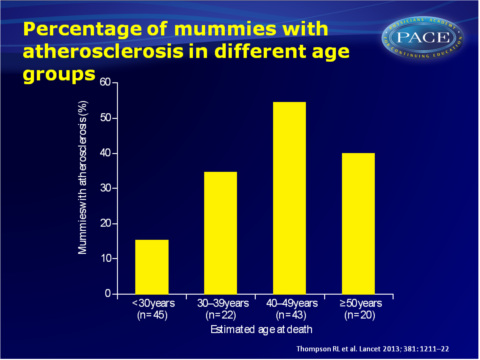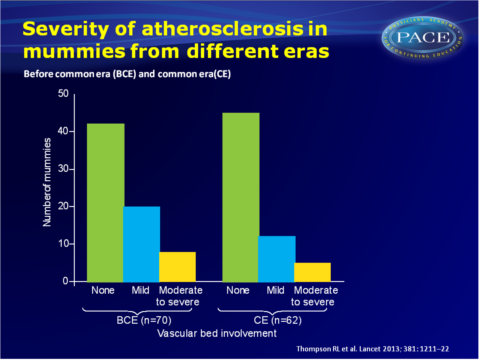Atherosclerosis exists for over 5000 years
Arterial calcifications seen in mummies from diverse preindustrial cultures: is atherosclerosis an inherent component of ageing, rather than a result of modern lifestyle?
Atherosclerosis across 4000 years of human history: the Horus study of four ancient populations.Literature - Thompson RC, Allam AH, Lombardi GP, et al. - Lancet. 2013 Apr 6;381(9873):1211-22.
Thompson RC, Allam AH, Lombardi GP, et al.
Lancet. 2013 Apr 6;381(9873):1211-22. doi: 10.1016/S0140-6736(13)60598-X.
Background
Atherosclerosis is commonly assumed to be a result of modern lifestyle. Its prevalence in the preindustrial era is, however, unknown.Ancient human cultures have discovered how to mummify their dead, thus providing material for a natural experiment: this study aimed to assess the extent of vascular calcifications in preindustrial or preagricultural human beings, using modern CT scanning. Vascular calcification is a common component of mature atherosclerotic plaque and pathognomonic for atherosclerosis in modern day humans [1]. Calcification indicative of atherosclerosis has been identified with CT in a mummified subjects who lived around 3000 BCE (before common era)[2]. Evidence of atherosclerosis was also seen in autopsies of Egyptian mummies [3,4]. It should be noted however that mummification was primarily performed on elite Egyptians, so lifestyle factors might have been involved in atherogenesis.
In the HORUS study, the authors therefore asked whether atherosclerosis was seen in numerous geographically and chronologically diverse ancient societies, with different diet and genetic makeup from people in ancient Egypt. 137 mummies from four disparate geographic regions were studied by whole body CT scanning. Definite atherosclerosis was defined as a calcified plaque in the wall of an artery and atherosclerosis was regarded as probable if calcifications were seen along he expected course of an artery.
Main results
- Probable or definite atherosclerosis was observed in 47 (34%) of 137 mummies, 25 of which were considered definite.
- Atherosclerosis was seen in all four studied populations: 29 (38%) of 76 Egyptians, 13 (25%) of 51 Peruvians, two (40%) of five Ancestral Puebloans (Southwest America), and three (60%) of five Unangan (now Alaska)(non significant difference between populations).
- Probable or definite atherosclerosis was seen in the aorta in 28 (20%) mummies, in iliofemoral arteries (25 mummies, 18%), popliteal or tibial arteries (25 mummies, 18%), in carotids (17 mummies, 12%) and in coronary arteries in six mummies (4%).
- Five vascular beds were examined. 34 mummies (25%) had atherosclerosis in one or two beds, 11 mummies (8%) in three to four beds and two mummies (1%) in all five beds.
- The odds of more severe atherosclerosis increased by about 69% per decade of life. After adjustment for mummy location (Egypt vs. Americas), age significantly increased the odds of atherosclerosis (OR per 10 year increase in age: 1.65, 95%CI: 1.15-2.36), while sex, time period and location were not significant.
Download PACE Thomson Lancet 2013.pptx


Conclusion
Atherosclerosis was prevalent in mummies from four different preindustrial cultures, including a pre-agricultural hunter-gatherer population, from distinct geographical regions and time periods. The diets varied between these populations, with protein sources ranging from domesticated cattle among farming Egyptians to a mostly marine diet in the hunter-gatherer culture of the Unangans. The use of fire for heating and cooking was common to all cultures, and exposure to smoke may have contributed to atherogenesis. Also, the likely high level of chronic infection may have promoted the inflammatory aspects of atherosclerosis. These observations suggest that the disease is an inherent component of human ageing rather than a characteristic of a specific diet or lifestyle.
Editorial comment [5]
Despite dying at young age, atheroma was evident In different ancient civilisations. Atheroma affects the circulation from an early time point and progresses throughout life. Some of the ancient populations were exposed to a fat-rich diet, but not all. Exposure to smoke from indoor fires was prominent in some cultures. Infection is likely to provide the unifying explanation of why the ancient populations should develop circulatory lesions. Inflammation is now considered to play a key role in circulatory and malignant processes. These data show that atheroma has been a burden on the human circulation for centuries.
References
1. Stary HC, Chandler AB, Dinsmore RE, et al. A definition of advanced types of atherosclerotic lesions and a histological classifi cation of atherosclerosis. A report from the Committee on Vascular Lesions of the Council on Arterosclerosis, American Heart Association. Circulation 1995; 92: 1355–74.
2. Murphy WA Jr, Nedden Dz Dz, Gostner P, et al. The iceman: discovery and imaging. Radiology 2003; 226: 614–29.
3. Allam AH, Thompson RC, Wann LS, et al. Computed tomographic assessment of atherosclerosis in ancient Egyptian mummies. JAMA 2009; 302: 2091–103.
4. Allam AH, Thompson RC, Wann LS, et al. Atherosclerosis in ancient Egyptian mummies: the Horus study. J Am Coll Cardiol Img 2011; 4: 315–27.
5. Heagerty AM. Scanning ancient history for evidence of modern diseases. Lancet 2013;381(9873):1165-6.
